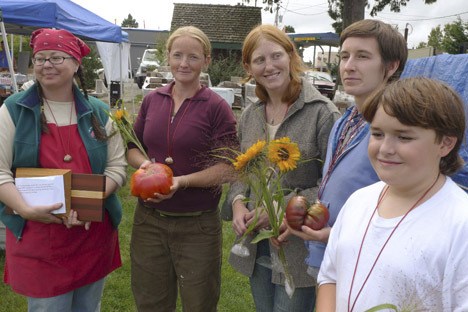I have this early memory of my Uncle Chuck. He’s standing in the garden of our favorite farmstand, haloed by morning sun. He bites into a tomato. Juice squirts into the light, runs down his chin. He tips his head back, grins and says through a cheekful, “Now that’s a good tomato.”
Wish I had tomatoes like that. Ol’ dependable Siletz comes early, abundantly enough for saucing, but in flavor it’s a little flat. Stupice has the taste, but it’s the size of golfballs and, at least in my garden, not very productive.
I could have spent a lifetime growing new varieties in search of that high-summer flavor. Instead, I went to the Farmer’s Market on Aug. 26 to get educated by the Tomato Taste-Off.
A rainbow of big flavor
I found VIGA Secretary Lindsay Hart surrounded by color: red, orange, golden tomatoes, even ones that were supposed to be green. Each sample plate was labeled by variety and category: best slicer, cherry tomato, biggest, weirdest and heirloom.
The whole point of the Taste-Off, said Hart, “is to educate people that there are tomato varieties other than Early Girl or Big Boy.”
At 11 a.m., we tasters, toothpicks poised, pounced on the samples: Ramapo, Paul Robeson, Jaune
Flamme. Suggestive names:
Egg Yolk, Amber, Brandy-wines. I scribbled notes:
“Oregon Spring: short taste, good meatiness, more tang than sweet — a 3.”
“Black Sea: a briny note, meaty texture, juicy flavor — a 4.”
“Aunt Ruby’s German Green: good … big fruit, clean, citrusy flavor, well-defined seed cavity — a 5.”
I elbowed past a young teen hovering near his Sun Golds. I speared, barked, “Oh, wow!” and marked my ballot: Best Cherry.
The largest category was the weirdly shaped, colorful heirlooms. Tasty Evergreen had a light citrusy flavor. Japanese Black Trifele was pear-shaped. Jaune Flamme was the color of tangerines.
And the famous, rose-red Brandywine was meaty and sweet, with an alcohol zing. It hit me: This is that taste I want — and it’s in heirloom tomatoes.
Taste-Off winners
Voting stopped at 1 p.m. with 134 ballots in. Local growers circled, waiting. When Hart called out “Best Slicer: Oregon Spring!” Jasper Forrester of Green Man Farm yelped.
Forrester said she grows 50 percent slicers, 50 percent heirlooms, which are “a learning curve because they’re a little funky — gnarly, sometimes cracked — but they’re wonderful.”
“Today I’ve noticed people wanting to talk about Oregon Spring and different varieties in general,” she said. “The questions I get are, ‘What does this taste like? How would you prepare it? How easy it is to grow?’ And that accomplishes everything we wanted to do with the Taste-Off: to get people to try something new, open up their palette and to think ahead about growing their own.”
She bowed as Hart draped “The Bronze Tomato” pendant around her neck that Hart designed and husband Jeff White cast.
Local woodworker Ralph Moore presented a plaque he’d made in honor of his grandma who “back in Lawrence, Kansas, used to grow these wonderful slicers that she’d peel for us grandkids.”
Pacific Crest Farm’s seven-inch “Ruby Gold” earned “Biggest” while Island Meadow Farm took “Weirdest.” Hogsback Farm won “Best Heirloom” for its Brandywine, while 12-year-old Dylan Grace-Wells of Stop Sign Farm won “Best Cherry” for the Sun Golds.
What makes them sweet?
Days later, I asked Hogs-back manager Brian Lowry what makes heirlooms special.
“They are older varieties whose seeds have been saved by gardeners from year to year,” he said. “The seed ‘comes true’ — you’ll get the same fruit from that seed as the mother plant produced. They’re not genetically modified.”
Heirlooms have been treasured by gardeners for their taste, but slice open a ripe one and you’ll see why they’ve lost favor with industrial growers. Inside is a gelatinous seed chamber — taste this and you’ll discover where a tomato’s acid tang comes from. Now bite into the outer wall: This is where sweetness concentrates as the flesh converts from starch to sugars.
These qualities — starch breaking down into sugars around a jelly center — make an heirloom too fragile for shipping. Commercial tomatoes are picked green and ripened with ethylene gas from the outside in, instead of the natural ripening that occurs from the inside out.
“For a really ripe tomato,” said Lowry, “look for uniform color and a bottom that’s a little soft.” He handed me a Brandywine. “This one will be good today, and perfect tomorrow.”
And perfect it was.
Most growers, such as Hogsback, Pacific Potager, Plum Forest Farm and Green Man, will have tomatoes for sale through October, but as Lowry said, “The prime season is now through the third week of September.”
Ripening tomatoes
In the garden: Stop watering, pinch off flowers and suckers, and cover plants with clear plastic. This retains heat and keeps off the rains that cause cracking and late blight.
In the kitchen: Pick tomatoes with a hint of their final color. Keep out of sunlight and definitely out of the fridge. Bananas, apples and ripening tomatoes produce ethylene gas that will help green fruits nearby ripen.
If frost threatens, pull the entire plant and hang it upside down in a dark, cool space like a garage or basement. Wrap individuals in newspaper. Check often through the next few weeks.
— Karen Dale, a freelance writer, grows Siletz, Stupice and Sweet Chelsea Cherries on hillside terraces on the south end of Vashon.



